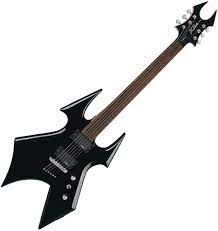Jak grać disco polo na gitarze?

Disco polo na gitarze ?
Nigdy nie byłem fanem muzyki disco polo… ba, nie byłem nawet fanem muzyki typu pop. Na pierwszą próbę z dawnym zespołem weselnym przyszedłem pewny siebie, swoich umiejętności i sprzętu. Przecież grałem już trudniejsze i ambitniejsze rzeczy- pomyślałem. Ubrany w ciężką skórę, buty z metalowym czubem i wyposażony w czarną gitarę z przystawkami typu humbacker czułem się jakbym pomylił zespoły. Wyraz twarzy reszty kapeli zdradzał ich myśli – „Będzie ciężko” albo „Lepiej wezwijcie egzorcystę”. Dali mi jednak szansę, ale już na samym początku rzucili mnie „na głęboką wodę”, czyli na znany weselny przebój disco polo- „Jesteś szalona”. Nie zdążyłem zagrać nawet całego wstępu, a basista(który miał też doświadczenie w graniu na elektryku) zabrał mi gitarę i przez 30 minut tłumaczył jak wygląda proste, typowe bicie w muzyce disco. Przez resztę próby szlifowałem tą ‚technikę’, z pokorą stwierdzając, że jednak dużo jeszcze muszę się nauczyć.
Przez kilka lat grania w różnych kapelach moje umiejętności nieco wzrosły i ze spokojnym sumieniem mogę powiedzieć, że nie ma jednego najlepszego sposobu grania disco. Wszystko zależy od klimatu utworu, od jego tempa czy nawet od ilości elementów typu refren, most, zwrotka. W tym artykule zamierzam wziąć „na warsztat” całkiem przyjazny w odsłuchu numer i dograć do niego ścieżkę gitary. Myślę, że będzie to bardzo pomocne dla osób, które zamierzają grać na imprezach okolicznościowych. Niestety, ale bez disco nie zagracie prawdziwej imprezy ? Zapraszam.
Co będzie użyte
Po pierwsze: cóż to za „całkiem przyjazny w odsłuchu” numer, który chcę zaprezentować? Otóż jest to utwór „Lazurowe oczy” autorstwa Magdy Niewińskiej. Aranż do tej produkcji oczywiście zakupiłem legalnie do celów komercyjnych, więc używanie go do nagrywania swojego dema raczej nie wchodzi w grę.
Użyta zostanie również gitara elektryczna Fender Stratocaster z przystawkami single coil. Dźwięk z niej będzie przetwarzany przez wtyczki VST, symulujące działanie wzmacniaczy, kolumn i kostek efektowych. Nie opisuję szczegółów, gdyż nie to będzie tutaj najważniejsze.
Jak to będzie wyglądać
Utwór w stylu disco jest podzielony najczęściej na 3 elementy, które są różnie rozmieszczone i mają różne długości. Są to mostek(melodia), zwrotka i refren. Czasami zdarza się, że usłyszymy jakieś konkretniejsze solo. Z mojego aranżu wyciąłem te trzy elementy i to do nich będę dogrywał gitarę. Przedstawię 9 różnych sposobów grania. Najpierw krótki opis, a pod nim prosty player z załadowaną konkretną próbką. Myślę, że już na wstępie mogę powiedzieć, że najlepiej jest mieszać te techniki zależnie od sytuacji. Jeżeli zrobimy to z wyczuciem, to na pewno będziemy docenieni przez zespół i gości (jeżeli w ogóle zauważą i usłyszą, że gramy :). Co do samych próbek, to nie starałem się jakoś specjalnie skupiać na dublach, więc gdzieniegdzie może pojawić się jakiś błąd czy wypad z rytmu. Przy nagrywaniu konkretnego dema na stronę internetową, błędy tego typu nie mogą mieć miejsca. Ostatnia sprawa- głośność gitary jest dopasowana mniej więcej tak, jakbyśmy ją kręcili na imprezie. Zaczynamy.
Poziom 0 – pojedyncza struna
Mogłoby się wydawać, że zrobiłem to dla śmiechu, ale faktycznie widziałem ludzi, którzy tak grali. Chodzi o to, żeby podłączyć jakąkolwiek gitarę (nawet za 199zł) do miksera i grać (zgodnie z akordami i w tempie) pojedyncze struny- pierwsze dźwięki akordu. Będzie to brzmiało bardzo słabo, ale faktem jest, że będziemy grać. Dlaczego wystarczy gitara za 199zł? Ba, wystarczy nawet gitara z jedną struną- najlepiej najgrubszą e. Najważniejsze jest, aby chociaż ta jedna struna trzymała jakoś ten strój na progach. Na gitarze tej jakości nie zagramy pełnych akordów, bo prawdopodobnie każda struna będzie rozstrojona.
Poziom 1 – akordy pełne, DI
Skrót DI oznacza brak jakichkolwiek symulacji, efektów i mikrofonów. Jest to sygnał wpięty bezpośrednio z gitary do interfejsu bądź miksera. Żeby zagrać na poziomie 1, musimy już znać podstawowe akordy (mogą być również barowe, lecz nie zawsze będzie to ładnie brzmiało). Cała sztuka polega na zagraniu pełnego akordu na początku taktu lub co dwa takty i trzymanie go, aż ucichnie lub zostanie zmieniony. Poziom 1 jest zbyt mało dynamiczny do skocznego disco polo, lecz zrobi na pewno lepsze wrażenie niż poziom 0.
Poziom 2 – akordy pełne, FX
Jedyna różnica między poziomem pierwszym, a drugim polega na wykorzystaniu efektów i symulacji. Słychać wyraźnie, że brzmienie gitary stało się przyjemniejsze i ciekawsze. Efekty, które zostały użyte i które najczęściej stosuje się do grania disco to: chorus, reverb, delay i eq parametryczny. Wszystko oczywiście w odpowiednich proporcjach, żeby nie przesadzić. Od tej pory, próbki na kanale czystym będą nagrywane z użyciem tych efektów.
Poziom 3 – akordy rozłożone
Czyli granie pełnych akordów, tyle że po jednej strunie na raz i to w różnych kombinacjach. Próbka wyjaśni o co chodzi. Ten sposób grania pasuje do wielu utworów, także w innych stylach. Nadaje im taki spokojny, czasem romantyczny klimat. Spokojnie możemy sobie pozwolić, aby podkręcić nasz delay i reverb.
Poziom 4 – standardowe bicie
To jest to, o czym pisałem na początku. Bardzo uniwersalny sposób grania disco. Gramy głównie akordami barowymi. Na zmianę jedno uderzenie w dół i jedno zacinające do góry. Dzięki temu utwór zyskuje bardziej dynamiczny klimat. Trzeba uważać tylko z efektem delay, gdyż może nam się zrobić niezły młyn. Standardowe bicie wymaga sporej sprawności od naszej lewej dłoni, a grubsze struny wystawiają naszą wytrzymałość na próbę.
Poziom 5 – standardowe bicie i pochodne akordów
Oprócz pełnych akordów możemy dodać dla zróżnicowania pochodne akordów. W sieci jest sporo kursów jak one wyglądają. Jeżeli odpowiednio dopasujemy pochodną akordu, to nasz sound będzie o wiele ciekawszy.
Poziom 6 – zróżnicowane bicie
Poziom szósty łączy w sobie bicie standardowe, pochodne akordów i bicie zróżnicowane. Jest to już wyższa szkoła jazdy, gdyż wymaga niezłego wyczucia, precyzji i wytrzymałości. Polega to na różnicowaniu częstotliwości uderzeń i losowym uderzaniu różnych strun, wszystko oczywiście dzieje się szybciej i jest bardziej męczące. Jeżeli chodzi o kanał czysty, to myślę, że w większości disco polówek takie granie będzie pasować.
Poziom 7 – tłumienie
Czyli wstęp do rocka. Tłumienie grane na kanale czystym jest monotonne, do disco raczej nie pasuje, ale mniej doświadczony gitarzysta potrafi ograć tak całe wesele (to również przykład z życia wzięty). Dźwięk jest przytłumiony, więc nie słychać za bardzo błędów, za to widać że gitarzysta coś tam gra.
Poziom 8 – overdrive
Utworów disco polo, w których można włączyć gęsty jak smoła fuzz, jest bardzo mało. Jeżeli już się taki trafi, to myślę, że warto przejść na tę „ciemną stronę mocy”. Oczywiście poziom zniekształcenia sygnału gitarowego możemy regulować, więc w wielu numerach świetnym rozwiązaniem będzie tzw. crunch i delikatne solowe wstawki. Poziom 8 oznacza jednak granie podkładowe przy mocno zniekształconym sygnale. Ktoś zapyta czy ludzie nie pouciekają z sali. Też tak wcześniej myślałem. Okazuje się, że overdrive bardzo napędza utwór i ludzie czując rockowy klimat bawią się jeszcze lepiej ? Oczywiście nie możemy przesadzić z głośnością. W poniższej próbce zwrotka jest zagrana techniką palm mutting, a refren i mostek na otwartych power chordach. Dzięki temu, w cichszej zwrotce nie zagłuszamy wokalu, a mocny refren podkreśla swoje znaczenie.
Poziom 9 – solo i riffy
To w dalszym ciągu mocne brzmienie, lecz wymagające większych umiejętności. Chodzi o to, że w różnych miejscach w utworze gramy solowe wstawki (improwizowane lub wyuczone), przeplatając je normalnym podkładem na kanale czystym lub przesterowanym. Niektórzy gitarzyści weselni grają tylko wstawki, zwracając tym na siebie uwagę publiczności. Przyznam, jeżeli ktoś ma spore doświadczenie i umiejętności to taka gra robi wrażenie. Solowe wstawki pasują w większości utworów w różnych stylach, trzeba zagrać je tylko w odpowiedniej skali i tonacji.
Podsumowanie
Sposobów grania disco jest na pewno więcej, lecz myślę, że jak ktoś opanuje te, które opisałem wyżej, to z pewnością poradzi sobie na każdej imprezie. To, czego będziemy musieli się nauczyć to: szybkie, wręcz odruchowe odnajdywanie każdego akordu, bicie w różnych tempach i skale gitarowe. Warto czasem włączyć sobie jakiś podkład (nieważne w jakim stylu) i próbować swoich sił w sztuce improwizacji. Pracujmy także nad odpowiednią artykulacją i precyzją grania.
